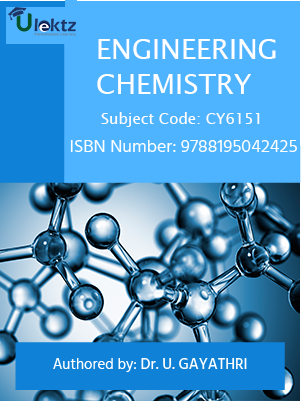

Note: Please check your Spam or Junk folder, in case you didn't receive the email with verification code.
Enter details or overview about the ebook
1.1 Introduction
1.2 Classification of polymers - Natural and synthetic
1.3 Thermoplastic and Thermosetting
1.4 Functionality
1.5 Degree of polymerization
1.6 Types and mechanism of polymerization
1.7 Addition (Free Radical, cationic and anionic)
1.8 Condensation and copolymerization
1.9 Properties of polymers
1.10 Tg (Glass transition temperature)
1.11 Tacticity
1.12 Molecular weight
1.13 Weight average
1.14 Number average and polydispersity index
1.15 Techniques of polymerization:Bulk,Emulsion,solution and suspension
1.16 Preparation
1.17 Properties and uses of Nylon 6,6
1.18 Epoxy resin - Uses
2.1 Terminology of thermodynamics
2.2 Second law
2.3 Entropy
2.4 Entropy change for an ideal gas
2.5 Reversible and irreversible processes
2.6 Entropy of phase transitions
2.7 Clausius inequality
2.8 Free energy and work function
2.9 Helmholtz and Gibbs free energy functions( Problems)
2.10 Criteria of spontaneity
2.11 Gibbs-Helmholtz equation-Problems
2.12 Clausius-Clapeyron equation
2.13 Maxwell relations
2.14 Van’t Hoff isotherm and isochore-Problems
3.1 Photochemistry: Laws of photochemistry
3.2 Grotthuss–Draper law
3.3 Stark–Einstein law
3.4 Lambert-Beer Law
3.5 Quantum efficiency
3.6 Determination
3.7 Photo processes - Internal Conversion, Inter-system crossing, Fluorescence, Phosphorescence, Chemiluminescence and Photo-sensitization
3.8 Spectroscopy
3.9 Electromagnetic spectrum
3.10 Absorption of radiation – Electronic, Vibrational and rotational transitions
3.11 UV-visible
3.12 IR spectroscopy -Principles,Instrumentation(block diagram only)
4.1 Phase rule: Introduction, definition of terms with examples, One Component System - water system - Reduced phase rule - Two Component Systems - classification – lead - silver system, zinc - magnesium system
4.2 Alloys: Introduction-Definition- Properties of alloys- Significance of alloying, Functions and effect of alloying elements- Ferrous alloys- Nichrome and Stainless steel – heat treatment of steel; Non-ferrous alloys – brass and bronze
5.1 Basics
5.2 Distinction between molecules-nanoparticles and bulk materials
5.3 Size-dependent properties
5.4 Nanoparticles
5.5 Nano cluster, Nano rod
5.6 Nanotube(CNT), Nanowire
5.7 Synthesis: Precipitation, Thermolysis, Hydrothermal, Solvothermal, Electro deposition, chemical vapour deposition, laser ablation, Properties and application
 No Preview is available for this book
No Preview is available for this book

 Get 100 instant uPoints on the purchase of Rs.100 or above for each order.
Get 100 instant uPoints on the purchase of Rs.100 or above for each order.
CategoriesEngineering Chemistry

Format PDF

TypeeBook